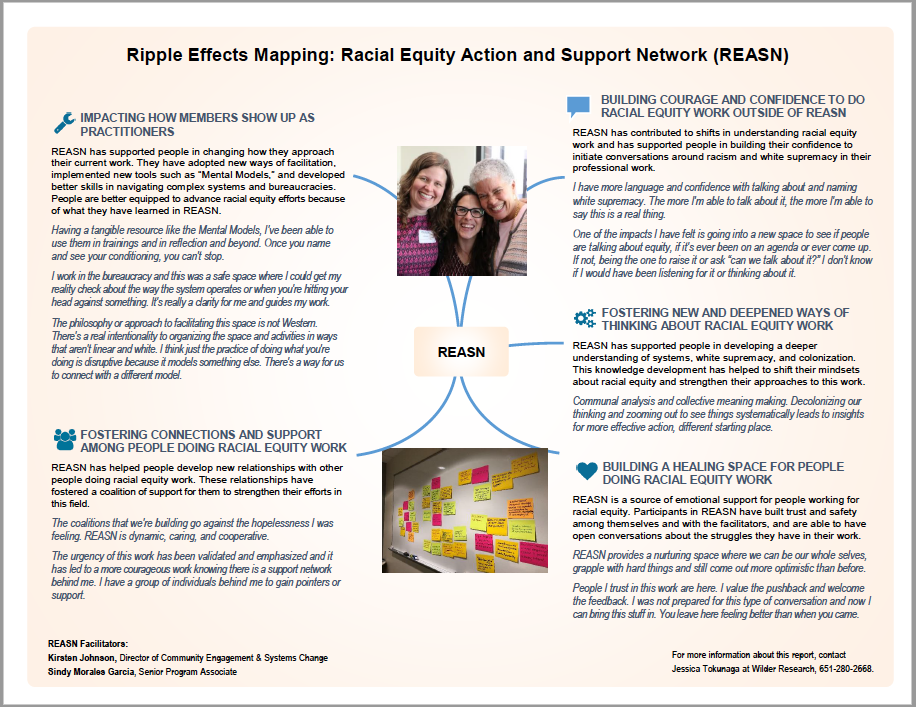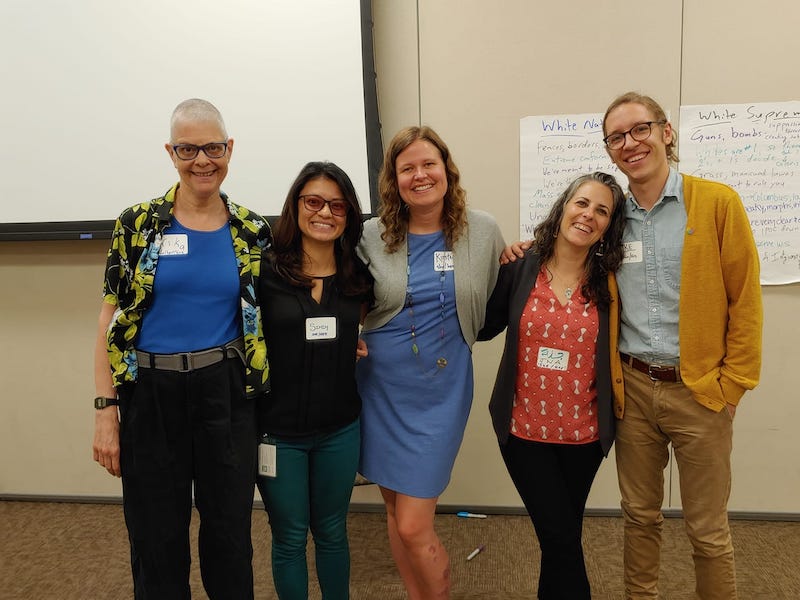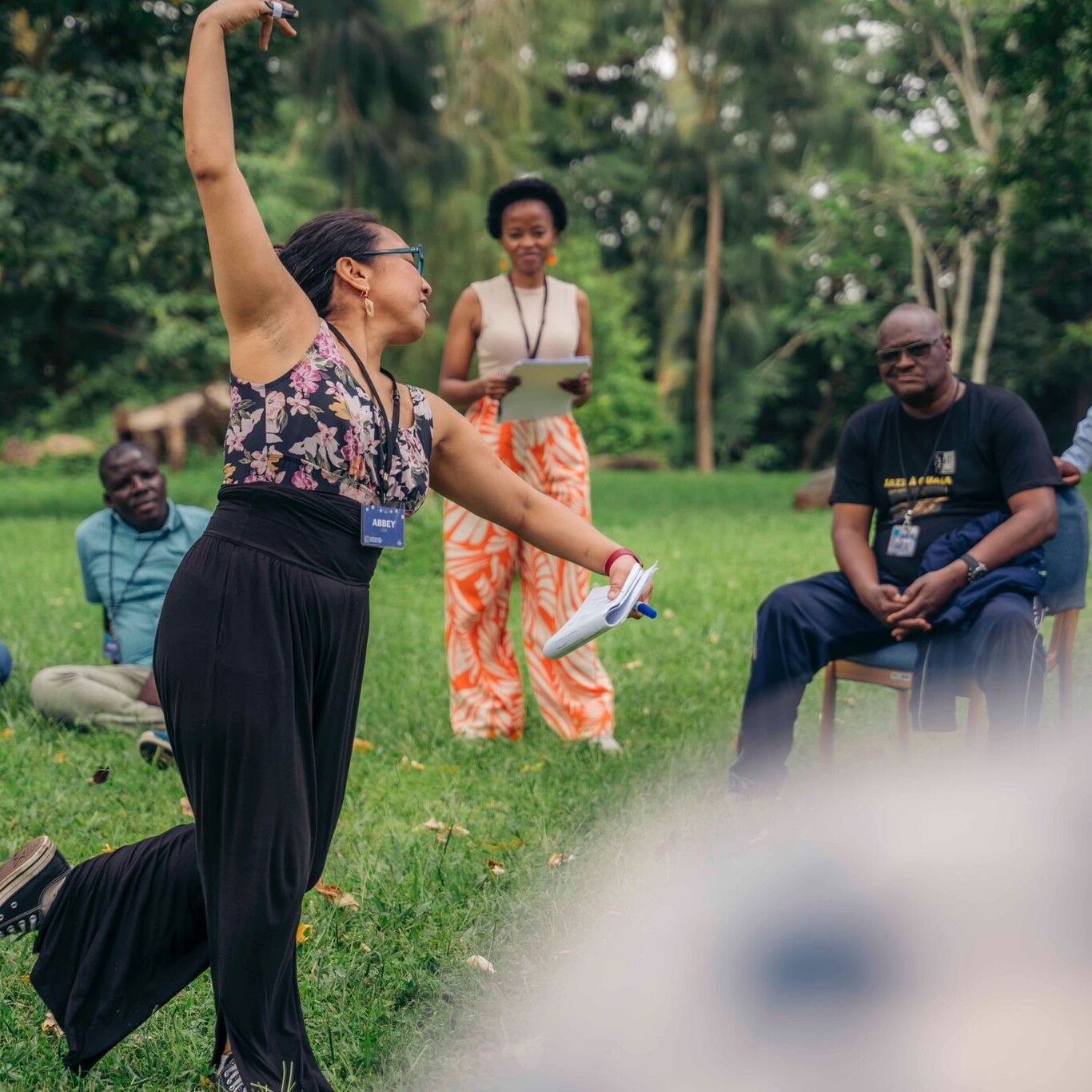Working to advance racial equity in systems and organizations is challenging and often isolating work. REASN – the Racial Equity Action Support Network – is a network in Minneapolis St. Paul that brings together Minnesota’s racial equity leaders and practitioners, the people whose job it is to design, facilitate and lead the efforts that enable community, nonprofit, and government organizations to advance equity. At REASN, these equity change agents find a space that provides:
- Support for doing the challenging, and often isolating work of creating racial equity
- Action strategies that are more powerful and effective as they are rooted in shared analysis and reflection
While there are many spaces that provide education and skill-building for those who are committed to racial equity, REASN is unique in offering a space for those who are responsible for leading those education, skill-building and systems change efforts. It provides a space of respite, learning and growth for those who are often in the position of hosting and supporting others.
In 2020, REASN could see transition on the horizon as funding and structural changes were underway in the organization that had served as its fiscal host. The network decided it was the opportune moment to invest in an evaluation that would document REASN’s impact over its 6 year history. Network members wanted to be able to tell the story of REASN to those who might support its sustainability. We chose ripple effect mapping as the evaluation tool to support us.
Ripple Effect Mapping
REASN hired a team of facilitators from Wilder Research to lead us through the Ripple Effect Mapping process. Network members worked alongside this team to create the purpose and questions that would guide the process.
Here’s how our evaluation partners at Wilder Research describe the process: Ripple Effect Mapping (REM) is an evaluation tool used to better understand the intended and unintended impacts of a project. It is particularly helpful when evaluating complex initiatives that both influence, and are impacted by, the community. REM is a facilitated discussion with staff and local stakeholders that creates a visual “mind map” during the discussion that shows the linkages between program activities and resulting changes in the community. This approach is intended to help demonstrate the project’s impacts more holistically and to describe the degree to which different types of impacts are observed by project staff and community stakeholders.
Ripple Effect Mapping appealed to us both because we felt it would capture the impact of our network, and because we thought it would expose our members to a new tool they could use in other parts of their work.
REASN Ripple Effect Mapping Process
REASN has about 40-50 actively engaged members in our network and double that number more loosely connected to our work. As we thought about who to include in our REM sessions, we set out to invite people with a range of participation levels in REASN; some who had been a part of the network since its creation and others who were more recent participants. We also wanted to engage a group that represented the diverse lived experiences of our network members. We ended up with a group of fourteen people who represented a variety of professions, races, ages, and gender-identities.
During the REM discussions, participants from REASN gathered to reflect on the impacts of their time in the network. We did our best to make the process transparent so that members could learn about REM while doing it. The questions asked during the REM discussions focused on participants’ personal and professional growth, how REASN supports their racial equity work, and observations about outcomes of their work. Here are some examples of the questions we used:
- What is one important change that you’ve seen or that you’ve experienced personally that has come out of the work of REASN?
- What new or deepened connections have you made with others as a result of REASN?
- How has REASN helped you disrupt the myths of white supremacy and colonization?
- How has REASN sharpened your thinking about advancing racial equity?
- What have you gained from the relationships you’ve developed in REASN?
As we answered these questions, we placed our post-its on the wall, pairs shared out from their conversations and our evaluation partners took thorough notes capturing the impacts we were naming. The process felt very organic and not unlike a discussion we would have at one of our quarterly network gatherings.
The observed impacts were grouped into five main types of changes that had taken place because of participating in REASN:
- Building courage and confidence
- Fostering new ways of thinking
- Building a healing space
- Fostering connections and support
- Impacting how people are as practitioners
A Season of Transition
As we thought might be the case, REASN in now in a period of transition as we explore possibilities for a new fiscal partner and funding sources. Our Ripple Effect Map is serving as a key asset in this process, reminding us of the impact of our network and why it’s worth the work to sustain it and helping us tell the story of our work to potential partners and funders.
featured image found HERE
The Racial Equity Action Support Network (REASN) brings together racial equity champions and advocates from community, nonprofit, and government organizations across Minnesota. Sindy Morales Garcia and Kirsten Johnson of Courageous Change Collective serve as network guardians for REASN.
PLEASE DONATE to help Network Weaver continue in it’s mission to offer free support and resources to networks worldwide.





